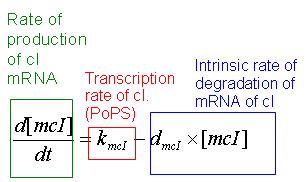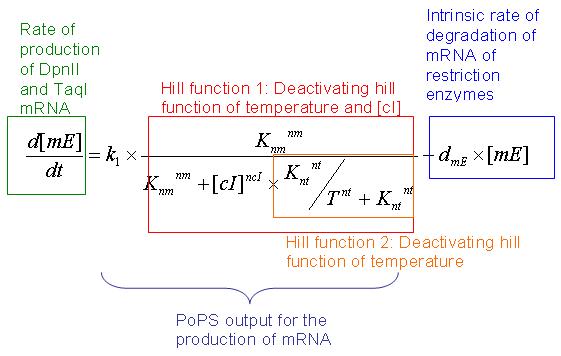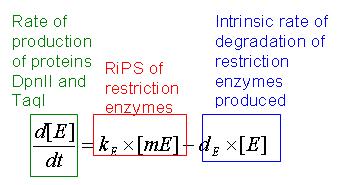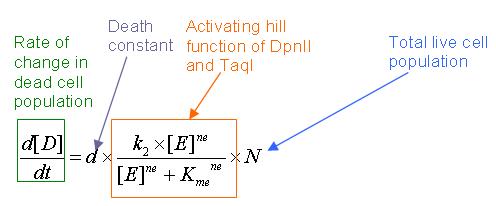IGEM:IMPERIAL/2009/M3/Modelling/Model1
From 2009.igem.org

We model the behaviour of our system with 6 differential equations. The first two are concerned with the production of protein cI, which represses killing. The next two tells us the production of restriction enzymes. Equation (5) describes the cell population, while equation (6) tells us the total number of dead cells. This will allow us to relate our model to the assays performed. (hyperlink to relevant assay)
Click HERE for the legend.
Equation 1: Equation describing the rate of production of mRNA of cI (Transcription)

The mRNA of cI protein is produced by the constitutive promoter, hence PoPS is a constant.
Equation 2: Equation describing the rate of production of cI (Translation)

The rate of production of protein cI is a balance between its production and its intrinsic rate of degradation.
Equation 3: Equation describing the rate of production of mRNA of restriction enzymes (Transcription)

Here, the rate of production of mRNA of the restriction enzymes is modelled by two terms.
The first term is the PoPS output. It is the combination of a repressing hill function of the concentration of functional cI protein, and deactivating hill function of temperature.
For a given temperature, the PoPS output is expected to be a hill function of the repressing protein cI. To model the effects that temperature has on the binding capacity of functional cI protein to lambda cI promoter, we model the cI protein concentration with a hill function of temperature.
The idea behind the assumption for this first term is that in a repressor system, the level of repression is determined by the concentration of promoters that are bound to the repressor. Furthermore, it is also commonly assumed that binding of the repressor to the promoter is at dynamic equilibrium, and thus the concentration of bound promoter is proportional to the concentration of free, unbound repressor. Both assumptions combine into the commonly used hill function of the repressor concentration to model the PoPS output.
In our case, the binding constant varies with regards to temperature. (It is high at low temperatures and very low at higher temperatures.)
In conclusion, our model states that the proportion of bound promoters is only a small fraction at high temperature of what it is at low temperatures.
Equation 4: Equation describing the rate of production of restriction enzymes. (Translation)

Here, the rate of production of enzyme is a balance of rate of transcription (RiPS) and rate of degradation of the enzyme itself.
Equation 5: Equation describing population change

The 5th equation relates the evolution of overall population to the internal concentration of enzymes.
This growth term shows that exponential cell growth occurs when there is no increase in temperature. The growth constant, g, will give us an idea how fast the exponential growth of the population is.
The death term comprises of the death constant, d, the activating hill function of restriction enzyme concentration, and total live cell population. An activating hill function is chosen based on the fact that an increase in restriction enzyme concentration will increase the probability of cell killing.
(Equation 6: Equation describing the population of dead E. coli )
The definition of the number of dead cell is the number of cells killed due to action of the enzymes.

This equation will link our model directly to the live and dead cells assay. Dead cells will display red fluorescence while live cells will display green fluorescence. Through spectroscopy at different time points, we can determine the rate of change in dead cell population, as well as total live cell population, N.
 "
"



